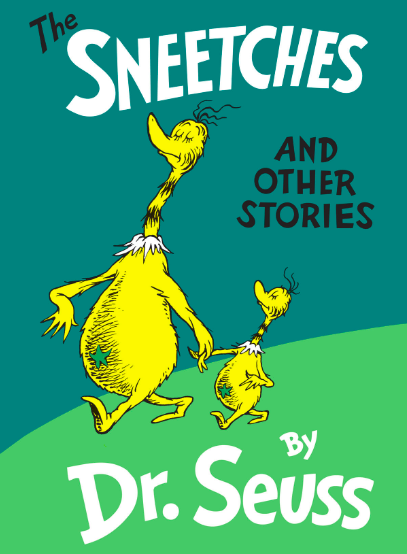The Sneetches
Book Module Navigation
Summary
The Sneetches is Dr. Seuss’s story about prejudice: the arbitrary features we focus on in trying to justify treating people differently.
There are two kinds of Sneetches: Star-Belly and Plain-Belly Sneetches. The only difference is stars on some of their bellies. And yet they Star-Belly Sneetches think they are superior to Plain-Belly Sneetches. They don’t allow each other to get along. Along comes a man who sells them stars and star-removals. This causes quite a mess; no one can remember who had stars and who didn’t. In the end, the Sneetches learn that they are all the same.
Read aloud video by Toadstools and Fairy Dust
Guidelines for Philosophical Discussion
The Sneetches is a book about two kinds of Sneetches: those with stars on their bellies and those without stars on their bellies. The Star-Belly Sneetches don’t like playing with the Plain-Belly Sneetches. The Star-Belly Sneetches think they are better than the Plain-Belly Sneetches. Along comes an entrepreneur who, in exchange for money, will place stars on the Plain-Belly Sneetches bellies. This sets up an arms race in an effort to remain special and superior; the Star-Belly Sneetches pay the entrepreneur to remove their stars from their bellies. This leads to confusion about who had stars and who didn’t. In the end, the Star-Belly Sneetches and the Plain-Belly Sneetches realize that they are all Sneetches and that they are all the same.
The book raises issues of differences, equality, and friendship. The first set of questions discusses differences. Children notice that there is difference in the world. They notice similarities as well. The questions challenge children to think about which differences matter and which differences don’t. What makes Plain-Belly Sneetches different from Star-Belly Sneetches, and humans from other humans? What makes one animal different from another kind of animal?
The next set of questions regards equality. The Sneetches treat each other differently based on the stars on their bellies. Children are asked to consider why the Sneetches should or should not treat each other differently based on the stars on their bellies. They are also asked more general questions regarding which differences might matter or might justify different treatment. Finally, this section helps children consider what shared characteristics among Sneetches and humans call for equal respect.
Lastly, the third set of questions ask about friendship in a broad sense. Children normally enter and exit friendships with peers very easily thus they are familiar with the dynamics in this kind of relationship. The questions require reflection on changing relationships. Why do people who are not friends before become friends? Why do people who disliked each other before become friends? Why do friendships end? Why is it good to be friends with others?
Questions for Philosophical Discussion
Differences
- What makes the Star-Belly Sneetches different from the Plain-Belly Sneetches?
- What makes the Star-Belly Sneetches similar to the Plain-Belly Sneetches?
- What makes a Sneetch a Sneetch – what makes it different from other animals or things? Is it how they look? Is it how they behave? Is it both?
- How do the Star-Belly Sneetches treat the Plain-Belly Sneetches? How do the Plain-Belly Sneetches treat the Star-Belly Sneetches?
- What are things that make humans different from one another?
- What are things that make humans the same?
Equality
- Do you think it is okay for the Star-Belly Sneetches to treat the Plain-Belly Sneetches the way they do?
- Do you think it is okay to treat those who look a little different from you differently?
- Do you think it is alright to treat those who look a lot different than you differently?
- What about those who act differently?
- Why did the Star-Belly Sneetches think they are better? Why did they think their difference meant they couldn’t be friends with the Plain-Belly Sneetches? Why did they set themselves apart?
- Are there any situations in which it is okay to treat two things differently because they are different? Imagine that one person in class is really smart. Should they be treated differently? If not, are there any examples you can think of where you would treat someone differently?
- Do any of these things make certain humans better than other humans? (Think about physical differences and personality/characteristic differences.)
- What makes humans equal to one another even when there are some physical or personality/characteristic differences between people?
Friendship
- What led the Star-Belly Sneetches and the Plain-Belly Sneetches to think they are all Sneetches?
- Is it pleasant for any of the Sneetches to live in a world where they don’t get along?
- Why is it good to have friends?
- Have you ever made friends with someone you didn’t initially like? What changed?
- Have you ever become friends with someone who initially didn’t like you?
- Do you think it’s good to try to be friends with someone you don’t immediately like?
- How do people make friends with people they didn’t like before?
- Why do people leave friendships?
- When should they leave a friendship?
- Why do people change their feelings toward someone else?
- Imagine you have two friends who don’t like each other. What kinds of things would you do to help them get along?
Original questions and guidelines for philosophical discussion by Lena Harwood archived here. Revised September 2020 by The Janet Prindle Institute for Ethics.






